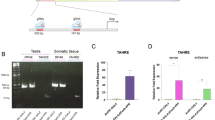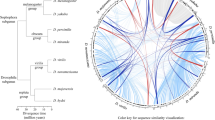Abstract
IN Drosophila melanogaster the heterochromatin comprises the whole of the Y chromosome, about the proximal third of the X chromosome and the centromeric areas of chromosomes 2 and 31–4. It appears throughout the cell cycle as darkly staining and highly condensed chromatin2,3 and replicates later than euchromatin during the synthetic period5. The heterochromatin of Drosophila is considered genetically inert because it contains very few mappable genes, although it has marked genetic effects in determining the well known position effect1. It has recently been found that the heterochromatin of Drosophila corresponds to the C bands6 and contains highly repetitive DNA7–12. None of these characteristics has, however, so far been of any use in solving the problem of the functional role of the heterochromatin. On the other hand, Drosophila offers unique possibilities for solving this problem, since in this organism it is possible to construct chromosomes containing different quantities of centromeric heterochromatin4,13 and thus study the functions of this material. Obviously this type of approach requires a preliminary study on the possible heterogeneity of the heterochromatin. An initial result in this type of study has been obtained by showing that the heterochromatin regions of D. melanogaster fluoresce differently after staining both with quinacrine14–16 and with the compound 33258 Hoechst17. Here we describe experiments in which the heterochromatin of Drosophila was differentiated by means of treatment of the living gangliar cells with 33258 Hoechst, which is known to decondense the centric heterochromatin of the mouse18.
This is a preview of subscription content, access via your institution
Access options
Subscribe to this journal
Receive 51 print issues and online access
$199.00 per year
only $3.90 per issue
Buy this article
- Purchase on Springer Link
- Instant access to full article PDF
Prices may be subject to local taxes which are calculated during checkout
Similar content being viewed by others
References
Hannah, A., Adv. Genet. 4, 87–121 (1951).
Heitz, E., Z. Zellforsch. 20, 237–287 (1933).
Kaufmann, B. P., J. Morph., 56, 125–155 (1934).
Lindsley, D., and Grell, E. H., Carnegie Inst. Wash. Publ. No. 627 (1968).
Barigozzi, C., Dolfini, S., Fraccaro, M., Rezzonico-Raimondi, G., and Tiepolo, L., Expl Cell Res., 43, 231–234 (1966).
Hsu, T. C., J. Hered., 62, 285–287 (1971).
Botchan, M., Kram, R., Schmid, C. W., and Hearst, J. E., Proc. natn. Acad. Sci. U.S.A., 68, 1125–1129 (1971).
Gall, J. G., Cohen, F. H., and Polan, M. D., Chromosoma, 33, 319–344 (1971).
Jones, K. W., and Robertson, F. W., Chromosoma, 31, 331–345 (1970).
Peacock, W. J., et al., Cold Spring Harb. Symp. quant. Biol., 38, 405–416 (1973).
Perreault, W. J., Kaufman, B. P., and Gay, H., Proc. natn. Acad. Sci. U.S.A., 70, 773–777 (1973).
Rae, P., Proc. natn. Acad. Sci. U.S.A., 67, 1018–1025 (1970).
Lindsley, D. L., et al., Genetics, 71, 157–184 (1972).
Adkisson, K. P., Perreault, W. J., and Gay, H., Chromosoma, 34, 190–205 (1972).
Faccio Dolfini, S., Chromosoma, 44, 383–391 (1974).
Vosa, C. G., Chromosoma, 31, 446–451 (1970).
Holmquist, G., Chromosoma, 49, 333–356 (1975).
Hilwig, I. and Gropp, A., Expl Cell Res., 81, 474–477 (1973).
Gatti, M., Tanzarella, C., and Olivieri, G., Nature, 247, 151–152 (1974).
Gatti, M., Tanzarella, C., and Olivieri, G., Genetics, 77, 701–719 (1974).
Jones, K., Nature, 225, 912–915 (1970).
Pardue, M. L., and Gall, J. G., Science, 168, 1356–1358 (1970).
Ellison, J. R., and Barr, H. J., Chromosoma, 36, 375–390 (1972).
Weisblum, B., and de Haseth, P. L., Proc. natn. Acad. Sci. U.S.A., 69, 629–632 (1972).
Weisblum, B., and Haenssler, E., Chromosoma, 46, 255–260 (1974).
Blumenfeld, M., and Forrest, H. S., Proc. natn. Acad. Sci. U.S.A., 68, 3145–3149 (1971).
Fansler, B. S., Travaglini, E. C., Loeb, L. A., and Schultz, J., Biochem. biophys. Res. Commun., 40, 1266–1272 (1970).
Author information
Authors and Affiliations
Rights and permissions
About this article
Cite this article
PIMPINELLI, S., GATTI, M. & DE MARCO, A. Evidence for heterogeneity in heterochromatin of Drosophila melanogaster. Nature 256, 335–337 (1975). https://doi.org/10.1038/256335a0
Received:
Accepted:
Issue Date:
DOI: https://doi.org/10.1038/256335a0
This article is cited by
-
High resolution of heterochromatin ofDrosophila melanogaster by distamycin A
Experientia (1983)
-
Quantitative variation of ?Mus musculus-like? constitutive heterochromatin and satellite DNA-sequences in the genus Mus
Chromosoma (1980)
-
Chromosome condensation and Hoechst 33258 fluorescence in meiotic chromosomes of the grasshopper Spathosternum prasiniferum (Walker)
Chromosoma (1979)
-
Condensation of all human chromosomes in phase G2 and early mitosis can be drastically inhibited by 33258-Hoechst treatment
Human Genetics (1979)
-
Change in chromosome concept
Proceedings / Indian Academy of Sciences (1978)
Comments
By submitting a comment you agree to abide by our Terms and Community Guidelines. If you find something abusive or that does not comply with our terms or guidelines please flag it as inappropriate.



